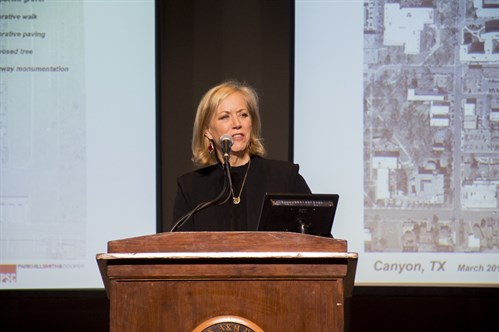CVM Dean Speaks About New Veterinary Education, Research & Outreach Center
Dr. Eleanor Green, the Carl B. King Dean of Veterinary Medicine at the Texas A&M College of Veterinary Medicine & Biomedical Sciences (CVM), spoke on Thursday about the significance of the new Veterinary Education, Research & Outreach Center (VERO) and what it means to establish a “superhighway” between Canyon and College Station.
Below are her comments:

You may have heard that around $90 million is being invested at West Texas A&M University (WT) to support veterinary medicine, agriculture, and rural Texas. I would expand on that figure to include the hundreds of millions of dollars invested over the years to create and sustain one of the largest and best veterinary colleges in the world.
This includes Texas A&M University’s recently completed $120 million Veterinary & Biomedical Education Complex, which has the capability to be a direct connection between College Station and the Panhandle for students, faculty researchers, educators, and others and gives us the capacity to educate as many veterinarians as Texas needs now and into the future.
This also includes the Texas A&M Veterinary Medical Teaching Hospital (VMTH), which trains veterinary students and serves Texans and their veterinarians, with unique features like the state-of-the-art Diagnostic Imaging & Cancer Treatment Center.
The research facilities house researchers who explore significant problems in animal and human health, while finding and sharing solutions in the Texas Panhandle, throughout Texas, across the nation, and around the world. By linking our campuses and regions, we are pooling capabilities to make available to the Texas Panhandle the resources of the Texas A&M CVM, including the talents of approximately 300 veterinary faculty. We also are making available to College Station the agricultural strengths of WTAMU, as the epicenter of the livestock industry.
Veterinary students in all four years of their curriculum will have exceptional opportunities to gain hands-on experience in rural and livestock veterinary medicine. The educational experiences will be led by Texas A&M veterinary faculty who live in the Panhandle and work at WTAMU. These hands-on opportunities will be available to all of the veterinary students, some seeking concentrated livestock experiences and some wanting to learn more about livestock agriculture before they choose their career paths. This new generation of veterinarians not only will serve food animal agriculture production and rural communities in this region but also will meet future needs in veterinary diagnostic labs, food safety regulatory agencies, and veterinary pharmaceutical research.
The VERO center will house on-site researchers who will form research teams between campuses and beyond, as needed, to address Panhandle-specific issues and those with broad impact on the livestock industries.
In summary, these shared resources will create and support for many years to come the best food animal veterinarian education and research program in the nation and the world. The combined investment and shared expertise at WTAMU, TAMU, and the TVMDL, along with partnering with local veterinarians through externships and internships, will contribute to this excellence in veterinary medicine.
In closing, this is one of the most exciting days for me as dean of the Texas A&M CVM. This is a dream come true, to expand the college strategically across Texas to “Serve Every Texan Every Day.”
To read the System’s VERO press release, click here.


